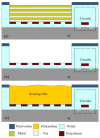Manufacture of a Polyaniline Nanofiber Ammonia Sensor Integrated with a Readout Circuit Using the CMOS-MEMS Technique
- PMID: 22399944
- PMCID: PMC3280836
- DOI: 10.3390/s90200869
Manufacture of a Polyaniline Nanofiber Ammonia Sensor Integrated with a Readout Circuit Using the CMOS-MEMS Technique
Abstract
This study presents the fabrication of a polyaniline nanofiber ammonia sensor integrated with a readout circuit on a chip using the commercial 0.35 μm complementary metal oxide semiconductor (CMOS) process and a post-process. The micro ammonia sensor consists of a sensing resistor and an ammonia sensing film. Polyaniline prepared by a chemical polymerization method was adopted as the ammonia sensing film. The fabrication of the ammonia sensor needs a post-process to etch the sacrificial layers and to expose the sensing resistor, and then the ammonia sensing film is coated on the sensing resistor. The ammonia sensor, which is of resistive type, changes its resistance when the sensing film adsorbs or desorbs ammonia gas. A readout circuit is employed to convert the resistance of the ammonia sensor into the voltage output. Experimental results show that the sensitivity of the ammonia sensor is about 0.88 mV/ppm at room temperature.
Keywords: Ammonia sensor; CMOS; Polyaniline; readout circuit.
Figures












References
-
- Timmer B., Olthuis W., Van Den Berg A. Ammonia sensors and their application-A review. Sens. Actuat. B. 2005;107:666–677.
-
- Christie S., Scorsone E., Persaud K., Kvasnik F. Remote detection of gaseous ammonia using the near infarad transmission peroperties of polyaniline. Sens. Actuat. B. 2003;90:163–169.
-
- Boeker P., Horner G., Roesier S. Monoliththic sensor array based on a quartz microbalance transducer with enhanced sensitivity for monitoring agricultural emissions. Sens. Actuat. B. 2000;70:37–42.
-
- Moos R., Muller R., Plog C., Knezevic A., Leye H., Irion E., Braun T., Marquardt K.J., Binder K. Selective ammonia exhaust gas sensor for automotive application. Sens. Actuat. B. 2002;83:181–189.
-
- Pushkarsky M.B., Webber M.E., Baghdassarian O., Narasimhan L.R., Patel C.K.N. Laser-based photoacoutic ammonia sensors for industrial applications. Appl. Phys. B. 2002;75:391–396.
LinkOut - more resources
Full Text Sources
Other Literature Sources

